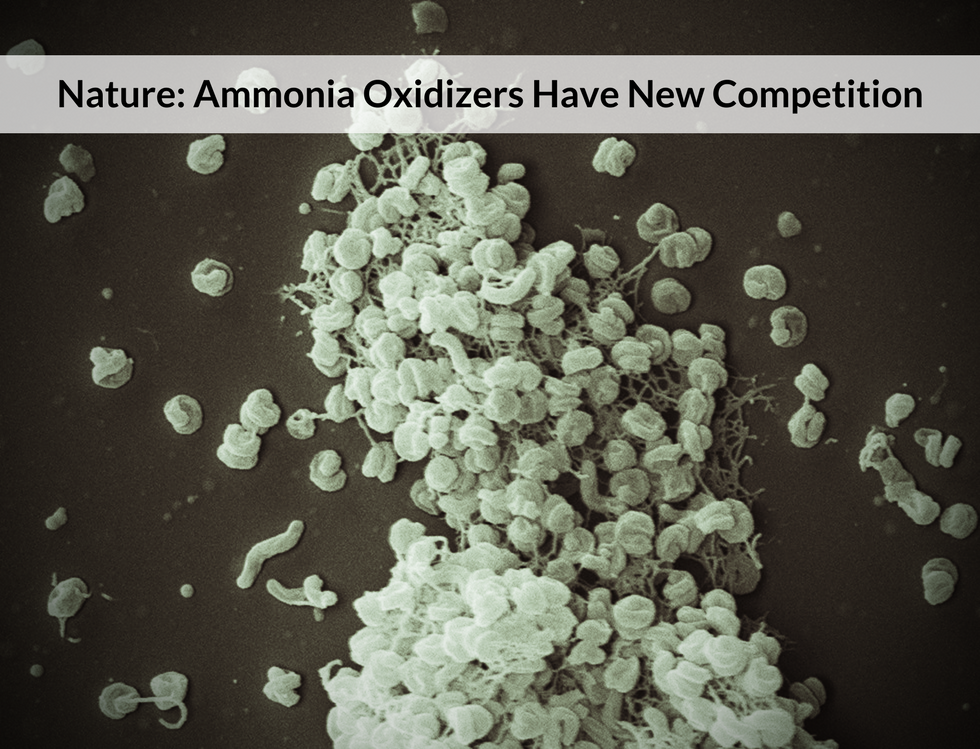The nitrogen cycle is incredibly important in many industries, such as agriculture and waste water treatment. The microbes involved in this cycle are the stars of the show; one bacteria in particular was highlighted in Nature this past week. In addition, NMT could further this research by measuring nitrogen-based molecules in this bacteria.
The Paper
One main step of the nitrogen cycle is when certain microbes take and oxidize ammonia (NH3) to use for energy. This step is interesting, because there are tons of bacteria and archaea eager for ammonia, but very little is actually available in their environment. They have to make do with the tiniest scraps they can find, and beat the competing microbes for food. Usually, the archaea prevail.
Nature just published "Kinetic analysis of a complete nitrifier reveals an oligotrophic lifestyle," by K. Dimitri Kits and Michael Wagner et al. of the University of Vienna. They cultured one particularly interesting bacteria, Nitrospira inopinata, that not only oxidizes ammonia, but nitrite (NO2−) as well, which is not common. They wondered, does this bacteria have an advantage over other ammonia-oxidizers? Who would win in a fight?
In this experiment, researchers compared three oxidizers on their affinity for ammonia: Ammonia-oxidizing bacteria (AOB), ammonia-oxidizing archaea (AOA), and Nitrospira inopinata. Out of the three, they found that N. inopinata had the best affinity. Even though it could fall back to another source of energy, this champion bacteria still made the most efficient use of ammonia, beating out it's closest competitors.
NMT Connection
It seems that NMT would be a perfect tool to further this research on the intriguing N. inopinata. Not only can NMT measure ammonium (NH4+) flux, but it also has sensors available for nitrate (NO3-), which is one of the products from this bacteria's reactions. NH4+ and NO3- have both been measured by NMT numerous times, such as in a Nitrosomonas europaea biofilm, in a study by Eric McLamore et al. in 2009. They measured a large biofilm measuring more than 5 cm both wide and long, but NMT can measure a wide variety of sample sizes, so smaller colonies could easily be tested as well.
Now, this new Nature study discovered that N. inopinata has an impressive ammonia affinity compared to other microbes. But when measured with NMT, what will its ammonium flux profile actually look like, and what will this indicate about it's use of ammonia? What will the nitrate efflux look like? How will these data look compared to the other microbes?
Only NMT can answer these questions with real time flux measurement in live colonies of N. inopinata. As this research moves forward, it will surely lead to new techniques for agricultural practices and wastewater protocols. One must wonder, what will be the next discovery about this amazing bacteria?
For more NMT connections, see NMT Publications: http://youngerusa.com/index.php/publications
References
K Dimitri Kits, et al. Kinetic analysis of a complete nitrifier reveals an oligotrophic lifestyle. Nature, 2017. 269–272.
Eric S. McLamore, et al. Non-invasive self-referencing electrochemical sensors for quantifying real-time biofilm analyte flux. Biotechnology and Bioengineering, 2009.102:791–799.
Photo Credit to K. Dimitri Kits, an author of the Nature paper.
New! Introducing "CNS and NMT" series
In this series of posts, you will learn something new that you cannot get anywhere else. Here you will find out how the latest research from Cell, Nature, and Science journals could go even further with the addition of new technology. We will show you how NMT can change the way that research is done, and how it can give a new perspective to studying the life sciences.
Thank you for reading!
Check Out More Applications NMT's most popular field is currently plant physiology, but creative scientists are applying it to new fields every day, like diabetes and cancer research. Now, labs using NMT systems have published over 700 papers in top journals! Our clients' top feedback is that the their high-quality results help them get published, thanks to the non-invasive nature of our technology, which allows them to measure live, physiologically accurate samples.
Experience the NMT Physiolyzer® Our most advanced NMT system yet: This highly advanced instrument is allowing scientists to discover physiological functions of live samples in innovative new ways. With customizable software, you can choose from 12 ions and molecules for your own personalized system.
The Theory of NMT Check out the principles of how NMT works.


